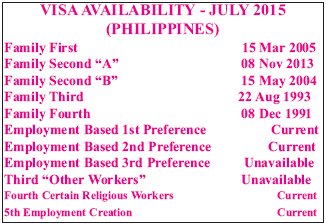By: Robert Gard
President Obama’s Executive Actions — Status of Implementation & Political Infighting — Part 5
Two key pieces (expanded “DACA” without age limits and “DAPA”) of President Obama’s Executive Actions Program, announced on November 20, 2014, were or are scheduled to go into effect on February 18th and May 26th of this year, respectively; but legal and political hurdles to implementation remain.
On November 20, 2014, President Obama announced his “immigration accountability executive action,” which includes a series of measures that are first steps towards common-sense reforms to an outdated immigration system. The series of executive actions presented by the administration range from new temporary immigration protections for many unauthorized parents of U.S. citizens and lawful permanent residents to highly technical regulatory proposals to fix outdated visa provisions. The USCIS website has a DACA page/link, where the public can sign up for emailed instructions, updates and further developments: http://www.uscis.gov/immigrationact ion
Status of Implementation and Political Infighting: Republicans have vowed to fight Obama’s immigration plan, charging the president overstepped his constitutional powers in taking the executive action. More than half of the States have sued the President, and they strategically “forum shopped” for a Federal District Court and a Federal District Judge who would be most likely to favor their position; settling on the Southern District of Texas, Brownsville Division, and Judge Andrew S. Hanen (appointed to the Federal Bench in 2002 by President George W. Bush). As of the date of my last article, Judge Hanen had issued a 123 page decision on February 16th, putting in place a preliminary injunction temporarily blocking implementation of President Obama’s new deferred action initiatives (expanded DACA and DAPA), while pointedly leaving the original 2012 version of DACA untouched and undisturbed. Judge Hanen indicated that his preliminary injunction was for the purpose of providing time for a coalition of 26 states to pursue a lawsuit seeking a permanent injunction against the President’s new deferred action initiatives. The Obama Administration then filed an emergency Motion to remove the injunction ordered by Judge Hanen on February 16th, and the Department of Justice (“DOJ”) has also appealed Judge Hanen’s decision.
The 5th Circuit Court of Appeals granted the Obama administration’s request for an expedited appeal, which could ultimately cut down the number of months before the court reaches a final decision. The 5th Circuit Court of Appeals held oral arguments on the Emergency Motion for a Stay of Judge Hanen’s decision on April 17th, with a decision on the Motion expected shortly thereafter. On Tuesday, May 26th, a three judge panel of the U.S. 5th Circuit Court of Appeals, by a vote of two to one in what appeared to be an overtly politically influenced ruling, chose to leave Judge Hanen’s injunction in place, and has set a date of July 10, 2015 for a hearing on the full appeal.
The U.S. Department of Justice has announced that they will not appeal the refusal to lift Judge Hanen’s injunction to the Supreme Court. In a statement, officials from the Justice Department said they disagreed with a decision by the United States Court of Appeals for the Fifth Circuit that continues to block the president’s immigration actions. But they said the government will fight on the merits of the program, rather than push for permission to carry it out immediately. Administration officials said the decision not to ask the Supreme Court to allow the program to move forward immediately reflects a practical reality: Even if the justices had given the green light to begin implementing the program, the continuing legal fight would probably have scared away most of the undocumented immigrants who could apply for it. The Department of Justice spokesman said the government will fight on the merits of the program, rather than push for permission to carry it out immediately.
If the Administration were to win at the appeals court later this summer, it is possible that Mr. Obama could order the program to begin later this year, however it’s very likely that whoever lost at the appeals court would ask the Supreme Court to consider the full merits of the president’s actions. If the Supreme Court agrees to hear the case, it would likely hear arguments during its term that begins in October 2015 and could issue a ruling the following June (2016). That would mean that the legal fate of the President’s immigration program would be decided just as the fall campaign for the 2016 presidential contest heats up, and would become just another “political football.” Another option that few commentators seem to be discussing is simply to publish the new proposed rules in the Federal Register, and go through the regular rulemaking process used for most regulatory changes (which probably should have been done in the first place.) While this would delay implementation for a few months, it would completely blunt one of the main arguments of the opposition.
Immigration advocates have now opened up a new front, asking the Administration to free immigrant families from “jail like” detention facilities. This includes putting heads of families into corporatelyowned prisons over a traffic ticket or minor driving offense until they are eventually deported or removed from the U.S., subsequently placing their U.S. Citizen children into foster care. This is the sort of thing that organizers will remember well into the 2016 election campaigns.
While the Focus has Been on DAPA, Expanded DACA, and the Politically Charged Blocking Maneuvers in Texas, There Were Many Other Initiatives Discussed in the President’s 11/20/2014 “Executive Actions”, and One Such Initiative is Now Emerging that, if Enacted, Could Help Many Employment-Based Beneficiaries Whose Sponsors Have Gone Out-of- Business or Have Withdrawn their Sponsorship
On Friday, May 22, 2015, DHS/USCIS published a notice of proposed rulemaking to advance one of President Obama’s Executive Initiatives for “modernizing” the employment-based immigration system. This publication or placing the issue on the DHS/USCIS regulatory agenda is the beginning of a process of formal rule making that could take about a year. From the published notice:
“Abstract: The Department of Homeland Security (DHS) is proposing to modernize the immigrant visa system by amending its regulations governing the adjustment of status process and employment-based immigration. Through this rule, DHS proposes to allow certain approved Immigrant Petition for Alien Worker (Form I-140) beneficiaries to obtain work authorization, clarify the meaning of portable work authorization, and remove unnecessary restrictions on the ability to change jobs or progress in careers, as well as provide relief to workers facing lengthy adjustment delays.”
In addition to the Federal Register publication of the notice of proposed rulemaking, a mysterious memorandum has been selectively “leaked” that provides greater detail of the proposal, but still leaves many questions concerning specifics, requirements, retroactivity, and advance parole authorization unanswered.
The memorandum notes that the USCIS has a working group on I-140 Executive Action initiatives and that the memorandum provides a legal assessment of two proposals under consideration. They are the following: USCIS would amend its regulations regarding the revocation or continued validity of approved I-140 petitions in cases where an employer withdraws the petition or terminates its business. Current regulations make such a revocation by USCIS automatic. The new rule would consider these I-140 petitions to remain valid for a beneficiary when “certain criteria are met.” USCIS would issue a new rule providing employment authorization to beneficiaries (and their derivative spouses and children) of approved employment-based immigrant visa petitions. The memorandum notes as well that while I-140 beneficiaries would be able to change jobs without fear of losing their underlying immigrant visa petition, most beneficiaries would be unable to adjust status in the US since they would no longer hold non-immigrant status. Consular processing would generally be the route to permanent residency (which, the memorandum notes, may have the side benefit of deterring fraud or misuse of the program). The I-140 revocation proposal envisions a system where approved I-140s continue to remain valid for the beneficiary despite the employer’s withdrawal of the petition or the termination of the business as long as 1) more than one year has passed since the approval of the petition and 2) the beneficiary has a job that is in the same or a similar occupational classification as the one in the I-140. This is very similar to the INA Section 204(j) provision for adjustment portability. The proposal would not alter other rules governing revocation such as those governing revocations for fraud or willful misrepresentation. This is certainly one of those “stay tuned for more exciting episodes” kind of issues.
QUICK NOTES: Immigrants and Their Advocates File Class Action Lawsuit Against USCIS and DHS for Unlawful Delays in Adjudicating Applications for Employment Authorization
On May 22, 2015, three immigrants and two immigration service providers filed a nationwide class action lawsuit against U.S. Citizenship and Immigration Services (USCIS) and the Department of Homeland Security (DHS) for unlawfully delaying the adjudication of their applications for employment authorization. The complaint alleges that USCIS’s policies and practices of failing to timely adjudicate applications for employment authorization documents (EADs) or, alternatively, failing to issue interim employment authorization, violate the governing regulations and the Administrative Procedure Act.
By regulation, USCIS must either adjudicate EAD applications within a fixed time period or issue interim employment authorization. Yet, USCIS regularly fails to do either, leaving immigrants in a precarious position, unable to work legally and at risk of losing their jobs, related benefits and, in some states, their driver’s licenses. USCIS local offices used to issue an interim employment authorization document (EAD) upon request when adjudication of I-765 Applications adjudications were taking longer than allowed by regulations. USCIS has recently stopped issuing such interim work authorization documents. Plaintiffs seek Court’s intervention to compel USCIS to adjudicate EAD applications within the time period mandated by the regulations or, if the regulatory time period has expired, issue interim employment authorization.
Employment authorization yields economic benefits not only for eligible noncitizens, but also for the U.S. economy. Individuals who can prove their eligibility to work in the United States earn higher wages than those who do not. Workers who earn higher wages are better able to provide for themselves and their families, pay more in federal and state taxes, and have more disposable income to spend on goods and services produced by U.S. businesses. Delays by the federal government in providing employment authorization to eligible immigrants undermine these goals. Moreover, employers may be forced to lay off these workers to avoid the risk of fines imposed by ICE.
COPYRIGHT BY AUTHOR — 2015
This article is designed to provide accurate and authoritative information in regard to the subject matter covered. It is published and distributed with the understanding that the publisher is not engaged in rendering legal, accounting or other professional service. It is submitted for publication by the author with the understanding that each individual case is different, and this article is not a formal legal opinion and should not be relied upon as advice by the author in a particular legal situation.
Mr. Gard has been engaged in the practice of immigration law since 1977. He is a frequent writer and lecturer in the American Immigration Lawyers Association and has served that professional organization as a Chapter Chair of the Greater Chicago Chapter, and as a Director.
 VIA Times – June 2015 Issue Vital News, Vibrant Views for Asian Americans in Chicago & Midwest
VIA Times – June 2015 Issue Vital News, Vibrant Views for Asian Americans in Chicago & Midwest





